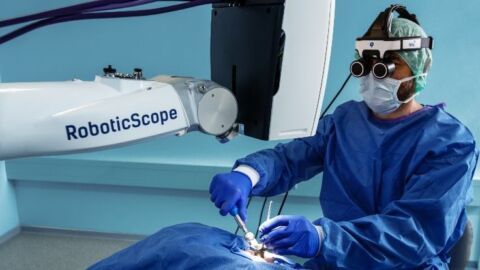ENT specialists at the University Hospital Zurich have recorded a world-first and used a ground-breaking new microscope during an operation. The device is controlled by head movements and can display an array of different angles, thus making operations not only more comfortable, but also faster and safer to perform.
RoboticScope, a 3D surgical microscope, is operated by tilting the head and enables the user to look at objects from different angles (image: bhs-technologies).
Performing surgery can be a strenuous undertaking, often requiring surgeons to work for hours bent rigidly over a small operating area. While most modern surgical microscopes for microsurgery offer good optical systems, they still have to be adjusted by hand. So changing perspective during an operation by adjusting the position of the microscope requires either the patient or the surgeon to change position. A surgeon wanting to examine a surgical site from a different angle will usually have to move to the other side of the operating table, laying down his or her instruments to do so. The brief interruptions that this causes add up during longer procedures, significantly extending operating times.

RoboticScope, a 3D surgical microscope, is operated by tilting the head and enables the user to look at objects from different angles (image: bhs-technologies).
The microscope is controlled via tiny gestures
The first-ever use of the pioneering RoboticScope during an operation took place recently at the University Hospital of Zurich’s Clinic for Ear, Nose, Throat and Facial Surgery (ORL). The procedure in question involved the reconstruction of a 69-year-old patient’s eardrum.
The microscope system, which is controlled via headset, is based on a high-resolution 3D camera installed on a robotic arm. The microscope and headset are not connected to each other so as to allow free movement. Small tilts of the head of body are sufficient to cause the microscope to move. Here, the headset detects the change of direction and transmits it to the position of the microscope’s 3D camera. The distance between the microscope and the surgical site can also be adjusted in this way. Control of the microscope is activated by foot pedal, allowing for the surgeon’s hands to remain in the operating area and keep hold of the operating instruments.
The resulting images can then be transferred from RoboticScope to a screen. This function is set to be used for training purposes later down the line, with assistants and doctors able to connect to the microscope directly and, via headsets and integrated augmented reality functionalities, observe procedures in real time.
RoboticScope was developed by the medical device manufacturer bhs-technologies with the involvement of specialists from the University Hospital of Zurich’s Clinic for Ear, Nose, Throat and Facial Surgery (ORL). The Clinic’s contributions were based on a research contract and saw its experts conduct a study to test the benefits of RoboticScope in terms of operating theatre technology and ergonomics.
Comfort and improved fields of view
“The freedom of movement and hands-free operation offered by this product give it multiple advantages over previous microscopes,” explains Professor Alexander Huber, Director of the Clinic for Ear, Nose, Throat and Facial Surgery at USZ. “Not that these are the only benefits to have impressed us: we are also very taken with its improved ergonomics and intuitive operation. We can now view the operating area from angles that we wouldn’t normally be able to achieve even by changing position at the operating table.” And while this feature may sound purely comfort-focused, its benefits are manifold. “Operations often take less time. This is an important factor in terms of further improving quality and patient safety. Having successfully launched RoboticScope as a treatment instrument, we will now be putting it to regular use.”
Your contact
Merlin Schär
MD-PhD student
merlin.schaer@usz.ch